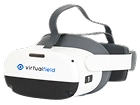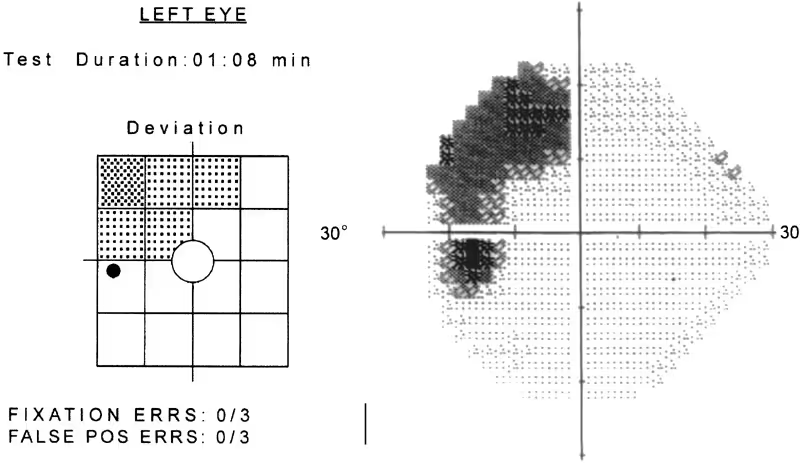Frequency doubling technology (FDT) is a vision test mainly used to detect early signs of glaucoma—making it one of the most widely used early glaucoma screening tools in both clinical and high-volume screening environments. As a fast and accessible option, the FDT visual field device plays a key role in identifying functional loss before patients experience symptoms.
Because of its speed and sensitivity, FDT has earned a place in both routine screenings and early glaucoma detection workflows. It’s a particularly valuable tool when time or resources are limited, as the test is quick and doesn’t require pupil dilation or a darkened room.
What Is FDT? (Frequency Doubling Technology Meaning)
FDT stands for Frequency Doubling Technology, a specialized form of perimetry used to screen for visual field loss, especially in glaucoma. In an FDT eye test, flickering black-and-white sine-wave gratings create the “frequency doubling” illusion, selectively stimulating the magnocellular pathway and enabling early detection of visual field defects. Frequency doubling perimetry is faster than many traditional tests and is widely used in both clinical and high-volume screening environments.
Frequency Doubling Technology Overview
FDT visual field testing stands apart because of its efficiency. Unlike full-threshold exams that require dedicated space and darkened rooms, a portable FDT perimeter offers flexibility in workflow while maintaining early disease detection accuracy.
These black and white stripes create a perceived doubling of spatial frequency. This "frequency doubling" effect selectively stimulates the magnocellular pathway, specifically M-cells, which are among the first to be damaged in glaucoma. If the patient’s retinal ganglion cells are impaired, this can be an early sign of glaucoma.
FDT visual field testing stands apart because of its efficiency. Traditional perimetry can take 10 to 15 minutes per eye, whereas FDT can complete a reliable test in under five minutes. Academic references and clinical validation
Academic references and clinical validation
A comparison study showed that frequency doubling technology may be more sensitive and specific than Standard automated perimetry (SAP) to detect early visual field impairments in ocular hypertensive patients.
FDT is useful, but further testing will be needed. An older study showed that it is not a reliable way to screen for neurological visual field defects, and another noted that it is not suitable as a sole glaucoma screening test.
Today’s electronic devices, including smartphones, are capable of producing quality FDT tests. This functionality points to more accessible, technologically advanced testing where tabletop perimetry might not be available.
These findings reinforce FDT’s position as a reliable early glaucoma screening tool, especially when using a frequency doubling technology perimeter in environments where speed and sensitivity are essential.
Did You Know?
Our customers realize an average of 902% return on investment with Virtual Field.
.avif)
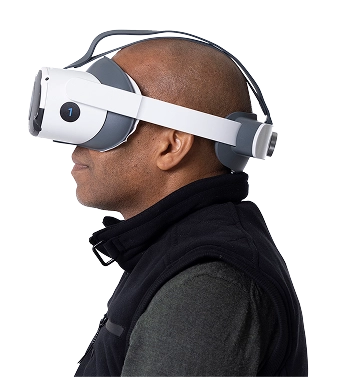
30 days free.
No strings attached.
We are confident you’ll love Virtual Field just like the 2,000 doctors who have already made the switch.
The FDT Eye Exam at a Glance
Because glaucomatous damage often begins in localized regions of the peripheral field, this makes FDT especially valuable as an early glaucoma screening tool, especially when used with a portable FDT perimeter for greater flexibility.
FDT perimetry presents patients with flickering black-and-white bars (sine-wave gratings) in different quadrants of the visual field. This test maps which regions of the visual field respond appropriately and which ones show defects. Because glaucomatous damage often begins in localized regions of the peripheral field, this test allows for early detection, sometimes even before a patient reports symptoms or before a full threshold test would register loss.
FDT Eye Test: How It Works and What to Expect
An FDT eye test (Frequency Doubling Technology test) uses specialized visual stimuli that appear to double in frequency, allowing clinicians to assess visual field sensitivity quickly and efficiently. Unlike full-threshold visual field exams, an FDT test can often be completed in under five minutes per eye using a portable FDT perimeter or FDT visual field analyzer, making it well suited for busy clinics and large-scale screening programs.
During the test, flickering gratings are presented in different areas of the visual field. Patients press a response button whenever they detect the target stimulus. The results are used to generate a visual field map highlighting areas of reduced sensitivity, which may indicate early glaucomatous damage or other visual field abnormalities.
Pros and cons of Frequency Doubling Technology Testing
The pros and cons that follow can help guide you toward the ideal scenarios to incorporate this test into your patients' diagnostic assessments.
Pros
Screening is fast, portable, and easy to administer in almost any setting.
FDT is sensitive to early glaucomatous damage.
Works well with portable FDT perimeter setups, offering flexibility for mobile clinics or limited-space environments.
Integrates easily into routine exams as an early glaucoma screening tool.
Cons
Frequency doubling technology is not a full-threshold test and provides less detail than other perimetry exams.
It may miss non-glaucomatous visual field loss, such as that from neurological or retinal origins.
Patients may find the optical illusion confusing without a thorough explanation.
List of Ocular Diseases Monitored and Diagnoses Identified by Frequency Doubling Technology
Primary Open-Angle Glaucoma (POAG)
FDT is highly effective at catching early glaucoma detection by identifying functional loss in the m-cell pathways. It’s considered a leading early glaucoma screening tool in optometric and ophthalmologic practice.
Optic Neuropathies
FDT lacks specificity in distinguishing underlying causes, but frequency-doubling technology can detect visual field loss caused by optic neuritis.

2.7M
An estimated 2.7 million Americans over age 40 have POAG
4-5X
African Americans are 4–5 times more likely to develop POAG and tend to develop it earlier and more aggressively.
Neurological Conditions
FDT is not the first-line screening for most neurological conditions and may miss significant defects. However, it can be added to the screening workflow to identify a wide range of conditions, such as tumors, hemianopias, and more.
Example Frequency Doubling Technology Report
Source: Nature.com
Interpreting FDT Visual Field Results
An FDT visual field report highlights areas where a patient’s visual sensitivity falls below expected thresholds. Clinicians should review deviation maps and reliability indices to determine whether observed defects are consistent with glaucomatous visual field loss or other optic neuropathies. When results show consistent sensitivity reductions in one or more quadrants, this may indicate early nerve fiber layer damage commonly associated with glaucoma.
Compared to standard automated perimetry, FDT perimetry may detect visual field changes earlier in certain cases because it selectively targets magnocellular pathways that are often affected early in the course of glaucoma.
30 days free.
No strings attached.
We are confident you’ll love Virtual Field just like the 2,000 doctors who have already made the switch.
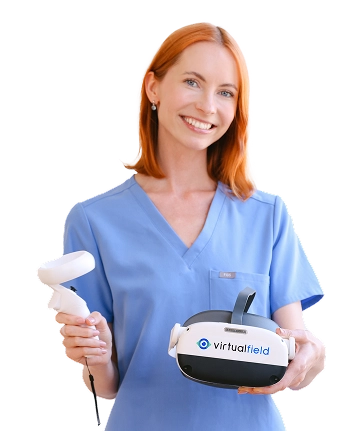
Billing and Coding for FDT Tests
When using a frequency doubling technology perimeter, CPT code 92081 allows you to bill for intermediate visual field assessments. According to the CMS physician fee schedule, reimbursement ranges from $15 to $42 per exam. Your specific fee amount depends on your practice’s location, setting, and the precise type of exam you’re providing.
When is the frequency doubling technology test required?
About three million Americans have glaucoma, and there are many more who don’t realize they have it. Patients at elevated risk of glaucoma — especially people over age 60, Black Americans over 40, people with diabetes, and those with a family history of glaucoma — should be screened frequently. Confirmed patients can benefit from FDT testing twice per year. Patients with suspected optic neuropathies may need frequency doubling technology testing when other tests are inconclusive.
Is FDT testing required for driver’s licenses?
No, this test is more specialized and doesn't provide insight into visual acuity, blind spots, or visual field. Driver’s licenses in all states require visual acuity testing, and many mandate visual field exams. The Esterman and Full Field 120 tests, when combined with visual acuity testing, usually provide ample information for drivers.
Complete Your Comprehensive Exams with Virtual Field
While FDT is not a substitute for full-threshold testing, using a portable FDT perimeter enables broader access to early detection—especially for at-risk populations.
Incorporating FDT into your diagnostic toolkit is a convenient and fast way to capture the earliest signs of functional vision loss before irreversible damage occurs. The quicker you identify subtle defects, the sooner you can begin treatment, slow progression, and preserve quality of life.
Virtual Field’s visual field tests can provide more insight and help monitor disease progression. You can add Virtual Field to your testing routines for comprehensive, precise, and patient-friendly eye exam experiences on a larger scale.
Want all 23 exam guides in one place?
Download our comprehensive guide for 160+ pages of insights.
FAQs
1. Why does an FDT visual-field test detect glaucoma earlier than a standard C-40 screen?
2. Why doesn't Virtual Field include frequency doubling technology?
3. Which CPT code should I bill for FDT?
4. What fixation-loss threshold fails an FDT test?
5. Is pupil dilation needed for FDT in older adults?
6. Can I compare FDT results to a Humphrey 24-2?
7. What does FDT stand for?
8. What is frequency doubling perimetry?
9. How do you interpret an FDT visual field test?
10. Is FDT useful for glaucoma?
Ready to get started?
Schedule a demo or begin your 30-day free trial of Virtual Field to try our EOM exam in your practice.
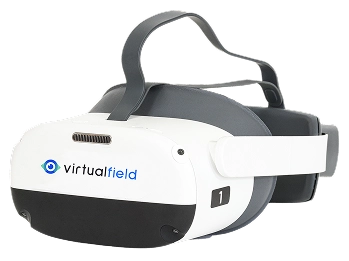
Questions? Contact sales@virtualfield.io talk to a Virtual Field expert today.

